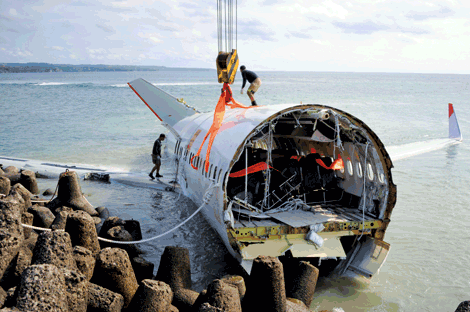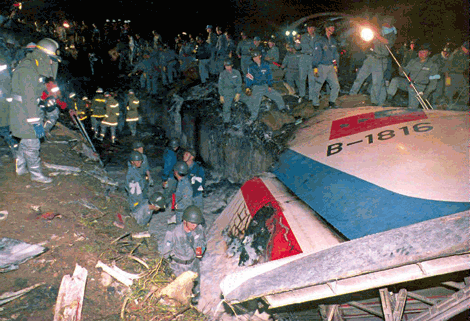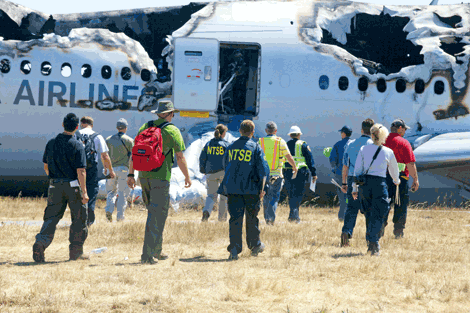A series of incidents involving a number of Asian carriers this year has reignited the discussion of aviation safety standards in the region.

Lion Air flight 904
Lion Air’s Flight 904 dropping into the sea next to the runway at Bali International Airport in April, Asiana Airlines Flight 204’s crash landing at San Francisco International Airport in July, and a domestic Lao Airlines flight falling into the Mekong River last month killing over 40 passengers have all imprinted a dramatic image on both international media and the public’s consciousness. August, meanwhile, saw the safety-related grounding of Zest Air, a low-cost carrier from The Philippines, a country that remains under a blanket ban on the EU aviation safety list along with Indonesia and Kazakhstan.
Asia-based airlines, meanwhile, represent almost 50 per cent of the bottom 10 out of 60 carriers named in the Jet Airliner Crash Data Evaluation Centre’s (JACDEC) 2012 safety ranking (see page 38). Accompanying smaller incidents, such as Korean Air and Thai Airways overshooting runways at Niigata Airport in August and Bangkok’s Suvarnabhumi early September respectively only add fuel to the argument’s fire.
“Just one incident can affect the entire industry,” says Will Horton, senior analyst for North Asia at CAPA – Centre for Aviation. “When Zest in the Philippines was grounded, it instantly sent shockwaves into northern Asia.”
But with notable exceptions such as Cathay Pacific and Singapore Airlines maintaining exceptional safety records, and victories such as Philippine Airlines’ (PAL) exemption from the EU safety blacklist earlier this year, he says the representation is one-sided. “I don’t think that that’s anything consistent in terms of incidents in this region… you get those types of incidents in other places around the world.”
But the haste with which the public is prepared to question the region’s aviation practices stems from a track record tainted by events of the past, particularly in the 1990s. However, these concerned a handful of carriers that have since worked hard to improve safety standards over the past two decades.
ASIA’S BAD REP
“Some time ago there were some structural problems in safety management with Garuda, China Airlines and Korean Air in particular – but there has been incredible changes,” says Horton.
Garuda Indonesia experienced a number of unfortunate accidents, notably two domestic departures, Flight 152 from Jakarta to Batam killing 234 in 1997 and Flight 200 from Jakarta to Yogyakarta in 2007, where more than 20 people lost their lives. That same year, the European Civil Aviation Conference judged that the Indonesian civil aviation authority had insufficient ability to implement and enforce safety standards to its air operators. This ban remains, but Garuda was exempted in 2009. Airfast Indonesia, Tigerair Mandala, Indonesia Air Asia, Indonesia Air Asia and corporate charter Premiair are four other exceptions.
Korean Air, meanwhile, suffered three major crashes in the 1990s – Flight 801 in 1997 from Seoul to Guam, where 228 people died, and cargo flights 8509 and 6316 in 1999, which went down in London Stansted and Shanghai and killed four and eight people respectively. These incidents were found to be pilot-related, and at the time there were many reports indicating that cultural reasons were at fault.
“With the Korean approach to hierarchy and relations with your peers, there was a co-pilot [on flight 801] who didn’t want to question a pilot and the result of that inaction was an incident that could have been avoided had the national culture been different – in that you don’t have this hierarchy – and that the priority of individuals is not to save face, but maintain safety,” Horton says.

Debris of a China Airlines A300 crash in 1994
In the 1990s, China Airlines experienced two major crashes involving Flights 140 and 676 from Taiwan to Nagoya and Bali respectively, both of which resulted in more than 200 fatalities. Then in 2002, Flight 611 bound for Hong Kong crashed into the Taiwan Strait, killing all 225 onboard. Many of these fatal incidents were also found to be the cause of pilot error.
This timetable of tragic events tarnished the reputation of safety in Asian aviation – something that the region has worked on in many different ways, but that still resonates to this day.
IMPROVING PROCEDURES
Both Korean Air and China Airlines faced criticism specifically directed at pilot and crew operations and responded by implementing a series of programmes and system improvements with a strong focus on staff training and procedures.
“Over the past 15 years, there have been significant and effective changes at Korean Air that have been lauded by media and aviation experts alike. These changes have raised the standard for airline safety programmes and exceeded all international safety criteria, including [those set by] the US’s Federal Aviation Administration,” says a Korean Air spokesperson.
In an attempt to synchronise safety practices with the North American market and counteract any malpractice seen as relating to Eastern culture and traditions, Korean Air initiated a multi-year contract to outsource pilot flight training to Boeing, the Flight Safety Foundation and Delta Airlines in 2000. Furthermore, “major changes were made in simulator training with more realistic scenarios including risk management, cockpit communications and decision-making,” says Korean Air.
Other training enhancements included more simulator time, semi-annual evaluations for all instructor pilots, lengthened stints at the crew resource management ground school and an error management course developed in cooperation with the University of Texas.
Changes made by China Airlines, meanwhile, follow a similar staff-centred approach. The Taiwanese carrier began cooperating with US-based Line Operations Safety Audit, which aims at developing countermeasures to operational errors by using, “highly trained observers to collect data about flight crew behaviour and crews’ strategies for managing threats, errors and undesirable states,” according to the airline.
Significant improvements were then noted at the IATA Operational Safety Audit (IOSA) of the airline in 2011, which were credited to, “minimising the operational pressure during flight crew’s pre-flight check, strengthening the prompts during takeoff and landing phases, incorporating audio-visual training material to heighten leadership, communications, crosschecking, management of work load, assertiveness, inquiry and advocacy,” say China Airlines.
In a demonstration of its commitment to improving aircraft maintenance checks, the carrier also established an advanced maintenance centre in Taipei capable of servicing five planes at once and employs the use of 120,000-pound engine test cells. The centre is also licensed to serve aircraft from the EU, US, Mainland China and Hong Kong-based carriers.
GARUDA INDONESIA SETS THE STANDARD
Garuda is currently the only airline in Indonesia to date to receive IOSA certification, something it attributes to, “implementing organisation standards of hazard identification, risk analysis, and mitigation processes in reactive, proactive and predictive ways in order to prevent incidents from recurring,” according to a spokesperson.
IOSA verifies airline organisation and management, flight operations, operational control and flight dispatch, engineering and maintenance, cabin operations, ground handling, cargo operation and security.
The IOSA’s blanket ban on the country’s other carriers such as Lion Air and Tigerair Mandala remain in place for the same failure to meet criteria as the Philippines and Kazakhstan.
PHILIPPINE SAFETY CONCERNS
In April, the European Commission and the European Aviation Safety Agency (EASA) visited The Philippines to review the country’s blacklist status, and concluded that the Civil Aviation Authority of the Philippines (CAAP) had yet to embrace modern aviation safety management techniques both internally and with the air carriers it supervises.
“In the operations area, there remains insufficient attention to human factors and safety management system processes,” the subsequent European Union Journal L190/54 states.
However, the report additionally acknowledges that, “the CAAP oversight of its air carriers was essentially sound although some weaknesses remained, particularly in the areas of training, standardisation, quality management and safety management systems.”
Due diligence was however demonstrated by the CAAP this August, when it grounded Zest Air’s entire fleet for four days after determining that the carrier was in violation of several safety regulations, including refuelling with passengers on board, failing to check aircraft log books, and exceeding permitted flying time.
Zest later reiterated in a statement that none of the issues raised by the CAAP were related to the safety and stability of its 11 A320 aircraft, but were rather procedural and technical matters that it has since addressed.
“In the case of Zest, the aircraft were not grounded out of concern that there was going to be an imminent crash but rather concern about how safety was being approached,” observes Horton. This proactive step can therefore be interpreted as demonstrating a move toward preventative policy in the CAAP and Philippine aviation.
Flag carrier PAL, meanwhile, was taken off the EU blacklist in July, and has passed the IATA audit repeatedly since 2008 and is thus IOSA-certified, and plans to launch a route to London this month.
All this is possible because PAL demonstrated, “the ability to ensure effective compliance with relevant aviation safety regulations,” according to the European Commission statement announcing its exemption.
ASTANA HEADS WEST
In Kazakhstan the country’s aviation authority, the Civil Aviation Committee, is yet to be declared compliant by the ICAO, which resulted in the EU ban back in July 2009. Flag carrier Air Astana is not included in the ban, but the number of frequencies it is allowed to operate in European airspace is restricted.
“We were exempted because we are partially regulated by the Department of Civil Aviation Aruba (a Dutch territory where the aircraft are registered) for our Certificates of Airworthiness, and by the UK Civil Aviation Authority for our EASA 145 maintenance license. We have also been on the IOSA register since 2007, and have a good track record and internal safety systems and processes,” says airline chief executive Peter Foster. Last month, the Kazakh national carrier launched a direct flight from Astana to London Heathrow, just a few months after it passed the IOSA for the fourth time in May.
KOREA’S NEW GUIDELINES

Asiana Airlines flight 204
Following Asiana Airlines crash in San Francisco in July, the causes for which are currently under investigation by the US’s National Transportation Safety Board, South Korea’s Ministry of Land, Infrastructure and Transport set up an airline safety committee to strengthen the country’s safety measures.
The committee is made up of government officers, aviation experts, university professors plus Asiana and Korean Air representatives, and will spend three months studying airline safety protocols and aviation systems. It will then set up preventative measures for any problems identified. By the end of the year, the committee will unveil a new set of measures, guidance and regulations for all South Korean airlines to follow.
ARRIVING SAFELY
Asia’s airline safety is undoubtedly much better than it was 20 years ago and inconsistencies in safety standards shouldn’t be viewed as a reflection of the region as a whole, Horton says.
The individual countries – and the standards of their regulatory bodies – are additional variables to consider on a case-by-case basis rather than region-wide. “It boils down to mentality, and how experienced you are with regulatory environments,” he adds.
Standards vary from country to country, and there are differing degrees of procedural safety among its carriers. Zest, for example, was grounded by the CAAP, while PAL is exempted entirely from the EU ban despite these two airlines operating in the same, currently blacklisted, country.
While there is evidence that lessons have been learned from the incidents and accidents of the past and aviation standards have seen improvements across the board, the previous experiences of carriers have little relevance to the challenges and hurdles faced by modern ones. “Korean Air and China Airlines safety changes were really quite some time ago, whereas current issues in a different environment,” says Horton.
Ultimately, what is most important is that an airline is aware of the limitations it faces, addresses them accordingly and reviews them regularly, something that many of the aforementioned carriers are doing.
“In terms of safety management, you don’t approach the topic of safety by saying ‘we’re not going to crash’ – you tackle it by saying, ‘let’s review the factors that lead to a crash or an incident’. Those factors could be cultural, how aircraft and parts are inspected before flights, what divisions have an input and for how long, and the upkeep and the maintenance [of planes],” concludes Horton.








